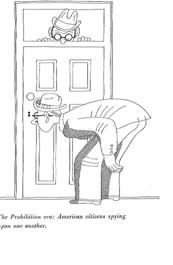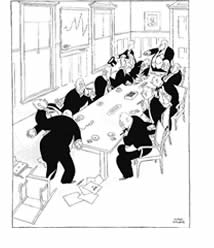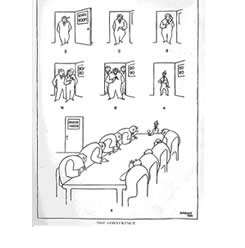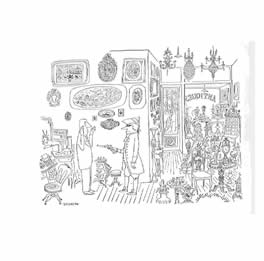|
One of the
debates in the Graphic Arts is the appropriate medium for communicating
humorous ideas. Early technical and economic pressures suggested the simple
unmodulated line carry ideas - Topfer and Busch. After 1860's a greater
tonality is seen in comic drawings for the national press (Du Maurier
and Keene in England for example). For the new narrative demands in the
twentieth century, art directors had a great range of markmaking (and
collage) to draw from. In The New Yorker , Addams and Mary Petty consistently
used the chalky, greasy, highly tonal surface - almost like J.F.Millet
at times. It was no coincidence that The New Yorker even
used the painterly Reginald Marsh for early cartoons - if serious visual
arguments against lynchings and racism can be subsumed in the genre. There
also grew up (heavily influenced by Caran D'Ache's work), a cartoon with
a fastidious and carefully drawn style, with emphasis on felicities of
outline, ingenuity of accessory and often blocky masses of black where
several items ( gents evening dress say) met.
Ralph Barton
was a founding father of the school of line artists. He worked for Vanity
Fair ,Judge and Life (the early humour magazine). He was most influential
on drawings for the smart set. He had studied art in Paris in his youth.
He was an utter perfectionist and constantly prey to gloomy feelings.
In 1931 he killed himself.
TOP LEFT
This is an illustration to his own book God's Country
Knopf NY 1929, the page measuring 14 x 20 cms
TOP MIDDLE Also to his own book God's Country Knopf NY
1929
An early disciple is the British artist in line, the prolific Nicholas
Bentley (1907 1978) whose authorship is always registered in the phrase"drew
the pictures".
TOP RIGHT
This an illustration to his father E.C.Bentley's Baseless Biography,
Constable London 1939. Here
accompanying the verse,
In Ruari McLean's introduction to a recent selection of Bentley's work,
the influence is well documented through the pages of the New Yorker .
'Gentlemen' said Burns
'Before the meeting adjourns
I think the least we can do
Is to declare that we are nae fou."
page 14 x 19 cms.
an unusual Bentley in the weight of black, from J.B.Morton (Beachcomber)
1933 and still going wrong, Eyre and Spottiswoode London 1932, a bilious
attack on just about everything with an unpleasant seam of racism. Page
measures 19 x 24 cms.
MIDDLE LEFT
Gluyas Williams (1888- ?) INDUSTRIAL CRISES series; A Director of the
Diamond Match Company Absentmindedly Lights his cigar with an Automatic
Lighter; The New Yorker 1930. Williams had trained as an artist in Paris
at Colorossi's Atelier and returned to be the leading graphic cartoonist
in America. The New Yorker and Life vied for his art, but Ross at the
New Yorker provided the most encouraging and critical stance as to what
humour was in visual terms. Williams was the master of gesture and the
accurate detailing of modern life.
High on the hillside, in a place apart,
Two that had found a road from heart to heart, ..."
to witness the excesses of advertisers' skywriting.
Gardner Rea, The Conference from The New Yorker 1930. Rea (1892 - 1966)
was already a freelance cartoonist at the age of 15. No fancy trips to
Paris for him. He worked extensively for Judge, Puck and then, from 1925,
for The New Yorker. He is an excellent example how early supple brush
work gave way to taut nervous lines, but blockier than Gluyas Williams.
He prospered more than Williams did with the grid of panels.
James Thurber, from The War Between Women and Men , in
The New Yorker. "The Rout."
Probably the closest Rea Irvin gets to Gluyas Williams; the day that they
sold a unit of stock, a reflection on the year after The Great Crash.
Rea Irvin (1881 - 1972) another defining figure in American cartooning;
Irvin was also a competent art director, starting with The New
Yorker in 1925, and staying until after the death of Ross in
1951. He worked for other magazines and also produced colour covers.
Saul Steinberg, from The New Yorker from The Late Forties
section of the Compilation 25th Anniversary Album Hamilton London 1951
The drawing in line could be really sophisticated and sell a product in
a magazine such as LIFE (the original humour magazine in the US printed
on poor quality paper in this edition in April 1930; L.Fellows, one of
a series of ads for Kelly Springfield tyres.
|







































